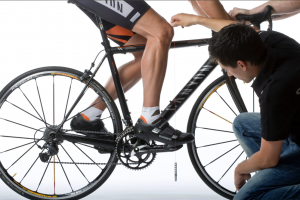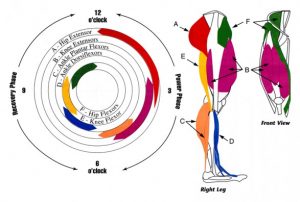Article by Jim Burke
Cycling is an activity that tends to be prescribed often in the presence of injury due to its low impact nature. A typical cyclist however, will perform something in the order of 5000-6000 pedal strokes per hour and as a result, overuse injuries in cycling are very common. In a survey of elite cyclists, the most common injury experienced was low back pain with over 40% reporting suffering from back pain but losing only 2-3 days per year as a result. The next most common complaint was knee pain with 32% of riders experiencing knee pain, however riders tended to lose much more time, typically 10-12 days of training as a result of their knee injury.
Due to the high volume of repetition, cycling provides plenty of scope for magnifying minor biomechanical issues, resulting in overuse injuries, particularly at the knee. These biomechanical issues may result from either poor strength, technique or bike set up.
Cycling incorporates all of the major leg muscles at different phases of the pedal stroke. The optimal bike set up is one in which all of these muscles are in their ideal length to generate power at the point of the pedal stroke when they are the most active. An optimal position on the bike should allow for the most efficient balance of forces on the body in order to prevent injury not only in the knee, but in other areas such as the hips and back.
Cycling predominantly involves use of the hips, knee and ankle joints. While the hip and ankle joint are designed to work in a range of positions, the knee functions essentially as a hinged joint, designed only for repetitive loading in the one plane.
In order for the knee to tolerate such high volumes of repetitive loading, it is important that the knee is loaded in a neutral plane, with the kneecap or patella, facing directly forward, and that excessive forces behind the patella are minimised. As the knee bends, the forces and loads behind the patella and in the tendons attaching to it are increased. This leads to a greater chance of overload to either the patella tendon or the cartilage covering either the back of the patella or the front of the femur with which it articulates.
Common issues with bike set up
With a correct bike set up, the inferior pole of the patella should be as close to dead centre of the pedal attachment onto the crank with the pedals at 3 o’clock and 9 o’clock. There are a number of common issues with bike set up which can lead to a change in this position of the knee relative to the pedal axis.
 Seat height.
Seat height.
If the seat height is too high, this will tend to draw the kneecap behind its ideal position. While this does not actually increase forces on the patella, it does place the muscles of the leg in a lengthened position, which has the effect of decreasing their power output and decreasing pedal efficiency. If the seat height is too low, this will tend to position the patella too far forward, increasing bend in the knee and forces on the patella
Crank length.
Incorrect cleat positon.
Seat fore/aft position.
Handlebar drop and fore/aft position.
Common biomechanical issues
Ok so now you have your bike set up just right, so problems solved? Not quite, the correct loading and tracking of the knee on the bike also relies on strength and technique. A common issue resulting in overload to the knee is excessive plantar flexion of the ankle through the pedal stroke. The ankle should remain in a relatively neutral position throughout the stroke, plantar flexion is the toe down position of the foot and ankle. Excessive plantarflexion has the effect of increasing the crank length or decreasing the saddle height at the top of the stroke and decreasing crank length or increasing saddle height at the bottom of the stroke.
Another common issue is allowing the knee to drift in or out through the pedal stroke. As previously stated, the knee is basically a hinge joint deigned to operate in a forward plane with repetitive movements. Any repeated rotation in the knee as a result of either medial or lateral drift of the knee, will result in excessive force on both the meniscus (cartilage inside the knee) as well as on the tissue around the patella. Commonly this medial or lateral drift is related to poor strength and control of the deeper muscles of the hip joint.
Bike set up
While this quick guide gives you some ideas on things to check and minor alterations that you may be able to make to your bike set up in the presence of knee pain, this is not an easy thing to do yourself while sitting on the bike. A thorough biomechanical assessment and bike fit by a qualified physiotherapist is always the best course of action if you are undertaking any significant amount of cycling, in order to prevent injury and keep you out there on the road. Remember prevention is always better than the cure! For information on our bike fit service, contact the practice

